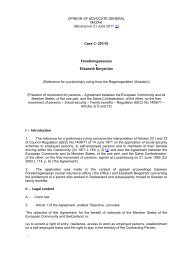Study on non-legislative initiatives for companies to promote gender ...
Study on non-legislative initiatives for companies to promote gender ...
Study on non-legislative initiatives for companies to promote gender ...
You also want an ePaper? Increase the reach of your titles
YUMPU automatically turns print PDFs into web optimized ePapers that Google loves.
100 Gender equality <strong>initiatives</strong><br />
o societal changes in educati<strong>on</strong> and labour market: the success rate of<br />
women in tertiary studies is high, the biggest growing populati<strong>on</strong> <strong>on</strong> the<br />
labour market are women;<br />
o societal changes have <strong>to</strong> be reflected <strong>to</strong> raise commitment of the<br />
employees;<br />
• changes in expectati<strong>on</strong>s of the younger generati<strong>on</strong>: growing rate of dual<br />
earners, changing roles in families - importance of work-life balance, flexibility in<br />
work organisati<strong>on</strong> (rising family obligati<strong>on</strong>s also <strong>for</strong> male employees);<br />
• research findings show that organisati<strong>on</strong>s that have women in senior positi<strong>on</strong>s<br />
are more likely <strong>to</strong> prosper.<br />
Internal drivers:<br />
• philosophy of <strong>gender</strong> equality is an integral part of the company, since the start<br />
of the business;<br />
• internal statistics show the discrepancy that while women are representing half<br />
of the work<strong>for</strong>ce, their shares in higher positi<strong>on</strong>s are relatively low;<br />
o analysis of internal statistics and figures reveal that women are not<br />
progressing in the firm in the way that the company would expect them<br />
<strong>to</strong>;<br />
o observati<strong>on</strong> that within the company women’s careers are progressing<br />
clearly slower than men’s;<br />
• sustainability of the work<strong>for</strong>ce: attract, retain and develop work<strong>for</strong>ce by<br />
guaranteeing access <strong>to</strong> skills, ensuring successi<strong>on</strong> and loyalty as well as<br />
keeping pers<strong>on</strong>nel costs in c<strong>on</strong>trol;<br />
o avoid the cost and competence loss when a well qualified (female)<br />
employee quits;<br />
• feeling that not all of the employees’ potential is being used in order <strong>to</strong> have<br />
maximum profit (both intrinsic and extrinsic) <strong>for</strong> the company;<br />
o take advantage of all different qualificati<strong>on</strong>s and talents of the<br />
employees;<br />
o skills and abilities of the employees can <strong>on</strong>ly be used <strong>to</strong> a maximum<br />
effect when the company helps <strong>to</strong> master the challenge of combining<br />
career and private life/family;<br />
o ameliorate the working climate and be a company where all employees<br />
feel valued and can develop competencies;<br />
• male and female cus<strong>to</strong>mers (marketing analysis shows that women in many<br />
cases carry out or influence purchase decisi<strong>on</strong>s);<br />
o industry specific motive: company operates in e. g. software engineering<br />
that is dominated by men; but the clients are men and women – the<br />
company there<strong>for</strong>e seeks <strong>to</strong> better understand the needs of their female<br />
clients;<br />
o company is more competitive when the structure of the cus<strong>to</strong>mers is<br />
reflected (easier <strong>to</strong> meet the cus<strong>to</strong>mers’ needs).
















